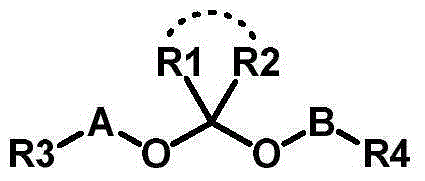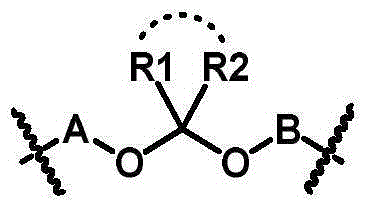Degradable organic aromatic amines and organic aromatic ammonium salt latent epoxy resin curing agent and its application
An epoxy resin curing and aromatic amine technology, applied in the field of epoxy resin curing agent, can solve the problems of difficult recycling of composite materials, environmental pollution, and lack of degradation function.
- Summary
- Abstract
- Description
- Claims
- Application Information
AI Technical Summary
Problems solved by technology
Method used
Image
Examples
Embodiment 1
[0102] Example 1: Preparation of curing agent i
[0103]
[0104] method 1:
[0105] In a 1-liter three-necked round-bottomed flask, 100 g of potassium 4-nitrophenolate and 98.3 g of dibromomethane were dissolved in 400 ml of N,N-dimethylformamide (DMF), and the resulting solution was heated at 120 °C for 18 hours. After that, DMF was concentrated in vacuo to recover DMF. After the residue was cooled, water was added until a yellow solid was precipitated, filtered, and the solid was dried in vacuo to obtain 70 g of 4,4'-dinitrodiphenolylmethane.
[0106] In a 2-liter three-necked round-bottomed flask, the intermediate 4,4'-dinitrodiphenolylmethane was dissolved in 1.5 liters of tetrahydrofuran, 7 grams of 10% Pd / C and 140 grams of 80% hydrazine hydrate were added, and heated to reflux for 10 After 1 hour, 10% Pd / C was recovered by cooling and suction filtration. After the mother liquor was evaporated to dryness, the residue was recrystallized with petroleum ether / ethyl ace...
Embodiment 2
[0112] Example 2: Preparation of curing agent ii
[0113]
[0114] In a 5-liter three-necked round-bottomed flask, 100 grams of 3-methyl-4-nitrophenol and 40 grams of potassium hydroxide were dissolved in 2.5 liters of ethanol, and reacted at room temperature for 5 hours. After the solvent was evaporated to dryness, 120 grams of Potassium 3-methyl-4-nitrophenolate.
[0115] This solid and 56 g of dibromomethane were dissolved in 500 ml of DMF, reacted at 120 ° C for 18 hours, concentrated under reduced pressure to recover DMF, after the residue was cooled, water was added until a yellow solid was precipitated, the precipitated solid was collected by filtration, and dried under vacuum to obtain 80 g of dibromomethane. (3-methyl-4-nitrophenol)methane.
[0116] In a 2-liter three-necked round-bottomed flask, add 80 grams of bis(3-methyl-4-nitrophenol)methane, 1.5 liters of dioxane and 4 grams of Raney-Ni, and add 140 grams of 80% 80% dropwise under heating under reflux. Hydr...
Embodiment 3
[0119] Example 3: Preparation of curing agent iii
[0120]
[0121] In a 1-liter three-necked round-bottomed flask, 100 g of potassium 3-nitrophenolate and 98.3 g of dibromomethane were dissolved in 400 ml of N,N-dimethylformamide (DMF), and the resulting solution was heated at 125 °C for reaction After 10 hours, DMF was recovered by vacuum concentration. After the residue was cooled, water was added until no more yellow solid was precipitated. The precipitated solid was filtered, collected, and dried under vacuum to obtain 70 g of bis(3-nitrophenol)methane.
[0122] In a 2-liter three-necked round-bottomed flask, the intermediate was dissolved in 1.5 liters of dioxane, 7 grams of Raney-Ni was added, and 140 grams of 80% hydrazine hydrate was added dropwise under reflux under heating. After the addition was completed, TLC monitored The progress of the reaction, until the end of the reaction, suction filtration, reclaimed Raney-Ni, the mother liquor was concentrated in vacuo...
PUM
 Login to View More
Login to View More Abstract
Description
Claims
Application Information
 Login to View More
Login to View More - R&D
- Intellectual Property
- Life Sciences
- Materials
- Tech Scout
- Unparalleled Data Quality
- Higher Quality Content
- 60% Fewer Hallucinations
Browse by: Latest US Patents, China's latest patents, Technical Efficacy Thesaurus, Application Domain, Technology Topic, Popular Technical Reports.
© 2025 PatSnap. All rights reserved.Legal|Privacy policy|Modern Slavery Act Transparency Statement|Sitemap|About US| Contact US: help@patsnap.com



